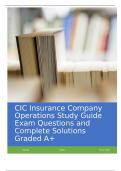CIC Insurance Company
Operations Study Guide
Exam Questions and
Complete Solutions
Graded A+
Denning [Date] [Course title]
,Explain the difference between strategy, strategic planning, and strategic plan - Answer: -strategy:
thoughtful, deliberate plan of action; chooses to be clear about the company's direction in relation to
what is happening in a dynamic environment; answers the question "how?" as in how will we achieve
our aim of creating and nurturing a successful insurance company
-strategic planning: the process used to create the strategic plan; runs an ERM analysis, which
determines risk and opportunities; conducts a SWOT analysis and helps answer these questions-- where
are we now? where are we going? how will we get there?
-strategic plan: the formulated roadmap that describes how the company executes its chosen strategy;
provides answers from initial SWOT; includes values, vision, and mission statements
what are the questions the EMT must answers before it starts the strategic planning process? And what
sources of info will be needed to answer these questions? - Answer: Three questions: What are we
now? Where are we going? How will we get there?
Sources of Info: Organizational values, market trends, regulatory guidelines, competitive analysis, risk
appetite
What tools can executive management team use to identify marketplace readiness and value
propositions to determine capital structure, surplus requirements, and investment sources? think
memory aid strategic mgmt FIE - Answer: strategy formulation, strategy implementation, strategy
evaluation
identify and describe the primary company structures and characteristics - Answer: 1. stock insurance
company: owned by stockholders (investors), primary objective is profit, ease of capitalization, mergers
and acquisitions easier, branding is easier, more pressure on topline growth
2. mutual insurance company: owned by policyholders, provides coverage at or near the cost of doing
business, profits used to pay dividends or used to reduce future premiums, focus is on bottom line
results, less pressure on day-to-day results, usually very stable, expansion more difficult because surplus
must be built over time, mergers and acquisitions more difficult
3. reciprocal insurance company: interinsurance exchange- individuals or organizations joined together,
subscribers insure one another, less pressure on profits because they operate close to the cost of doing
business, easier to capitalize, usually offer single line of business, subscribers make premium deposits,
managed by an attorney in fact, state insurance regulation may be less strict, difficult to raise additional
capital
,4. hybrid structures: use of holding companies to own and operate different company structures, can be
made up of stock, mutual, reciprocal, and other company structures
what are the two approaches the lead to the construction of the company's culture, describe each -
Answer: 1. passive approach- culture created over time. employees observe behavior and values of
mgmt and fellow employees functioning in self protective mode. few or no standards regarding work
behavior; higher levels of instability and inconsistency, turnover high, low job satisfaction
2. active approach- deliberate culture creation, leadership models behaviors that create the desired
culture, set stage for success by establishing solid foundation, positive employee engagement, customer
retention, growth targets become more in sync
describe the distinct purpose of each kind of statement: values, vision, and mission - Answer: -values
statement: a statement of commonly held, core values, that define the who of the organization. it often
is referred to as company's code of conduct; describes the central theme, or top priorities, of the
organization's culture "who" of the organization
-vision statement: the light that guides the company to its hopes and ambitions for the future; are the
foundation for the development and implementation of a long-term strategic plan "what do we want to
be when we grow up"
-mission statement: short but powerful statement regarding the reason an organization exists; it is the
why statement that states a company's core purpose and overall goal; it generally deals with the here
and now; identifies a company's operational goal, meaning the products it provides, the market(s) it
serves and geographical territories; what the organization needs to do in the moment to achieve vision;
"why"
What are the 3 duties of the board of directors - Answer: duty of care-- must make prudent decisions
using due diligence, gathering all relevant facts before making decisions
duty of loyalty-- keep interest of the organization the primary focus, may include disclosure of conflicts
of interest
, duty of obedience-- must be careful to follow the organization's bylaws, stated purpose, and applicable
laws
what are typical board committees - Answer: audit committee
nominating committee
governance committee
finance committee
typical executive positions you find in the insurance company - Answer: CEO, CFO, President, VP Claims,
VP sales and marketing, Chief Underwriting Officer, Chief Claims Officer
What is the relationship between a company's risk tolerance and risk appetite and the EMT's decision-
making process? - Answer: Risk Tolerance: The maximum amount of risk a person or organization is
willing to assume
Risk Appetite: The maximum amount of risk the organization is willing to accept while striving to meet
its strategic and tactical plans
what business decisions result from risk appetite - Answer: -single line or multiline-- are you going to
focus on one line of business and become and expert and risk losing the market, or choose to have
balance it needs to survive during market changes as it is rare two or more lines of insurance will be
affected in any given market cycle, expense may be greater as may need multiple uw teams for example
-specialist or generalist-- focus only on few types of risk or write all different types of businesses rather
than focusing on specific types
-geographic footprint-- where do you want to write, a single state or multiple states where it wants to
sell or will it start in one state and expand over time
-reception by distribution-- how receptive are agents in the area to new companies, consider regulatory
and judicial environments




